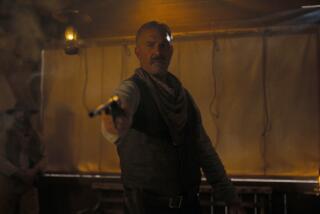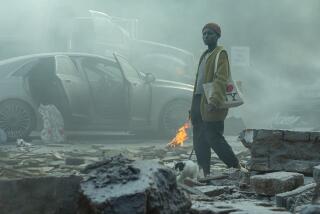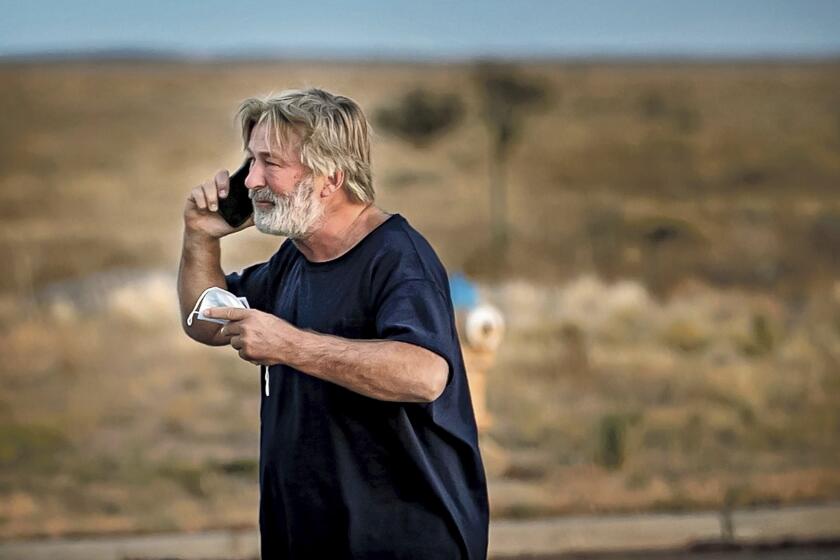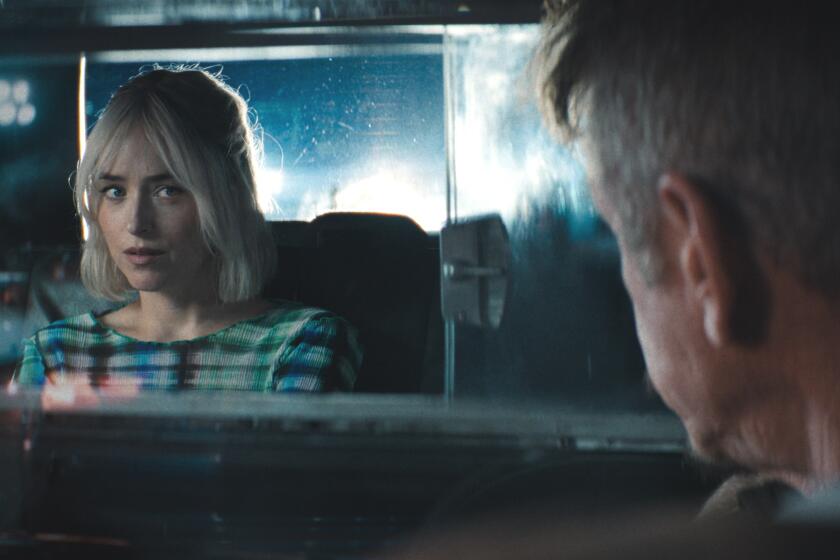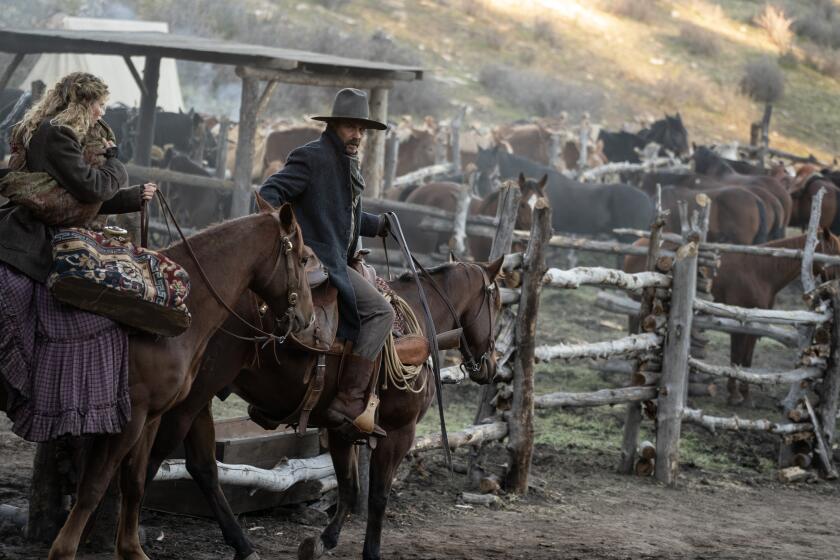The Renaissance of Michael Keaton : Latest Role in ‘Clean and Sober’ Puts a New and Serious Spin on the Screen Image of an Actor Who’s Best Known for Comedy
There is something unpredictable, unnervingly explosive about Michael Keaton’s performance in director Glenn Gordon Caron’s “Clean and Sober”--”a lot of danger lurking about,” as Caron puts it.
That’s not the screen image usually associated with Keaton, whose career as a comedic actor just one year ago seemed to have stalled on the same wise-cracking note. But Keaton’s performance in “Clean and Sober,” which opens nationally Wednesday, adds a whole new dimension to an actor who previously had been indelibly stamped on the public consciousness as a comic.
Surprisingly, Caron says he first spotted Keaton’s dark, explosive side in his 1982 film debut, “Nightshift,” a wacky comedy about two graveyard shift morgue attendants operating a brothel out of their unlikely work place. (“Just you and me and the stiffs here alone?” effuses Keaton’s Billy Blaze to Henry Winkler’s passive Chuck Lumley. “That’s gonna be radical!”)
Based on that one comedic performance six years ago, Caron made one of Hollywood’s more bizarre casting decisions: He hired Keaton for the lead role in the $14-million “Clean and Sober,” a brooding and poignant drama about a man’s battle with cocaine addiction.
Caron’s decision to offer the role--and Keaton’s reluctant decision to accept it--had all the makings of a potential disaster. Comedic actors rarely make a successful transition to complex dramatic parts. Just three years before Caron’s offer, Bill Murray had attempted it with “Razor’s Edge,” only to be lacerated by critics and totally ignored by ticket buyers.
But Keaton’s emotion-packed performance as Daryl Poynter--a man trapped in his life, as well as in a Philadelphia drug clinic--was so powerful that it lent the film a kind of “must-see” cache among Hollywood insiders. Even if “Clean and Sober’s” subject matter guarantees the film only limited audience appeal, as some suspect, Keaton’s performance is likely to give his own career a needed shot of adrenaline.
Somewhere between the box office successes of “Mr. Mom” in 1983 and “Beetlejuice” earlier this year, Keaton lost his calling card as Bankable Hollywood Star.
“Life is short in Hollywood,” said Harry Colomby, Keaton’s partner and business manager, speaking bluntly about the rise and fall of the actor’s stock. “You’re either in a buy position or a sell position. Half a year ago we were on the sell side.”
If the surprise success of “Beetlejuice” reassured wary studio executives that Keaton still has box-office draw, “Clean and Sober” could make skeptical directors sit up and take notice of his potential as a dramatic leading man.
“Michael’s going through a sort of renaissance,” says “Beetlejuice” director Tim Burton. “He’s one of the few comedic actors that can bridge that gap to drama.” But, Burton cautions, Keaton needs the right director. “Michael Keaton can be very subtle,” he says. “Film makers have to be able to tap into that.”
Burton will be directing Keaton once again. This time the film is a futuristic “Batman” and his co-star is Jack Nicholson. Coincidentally, early reactions to Keaton’s performance in “Clean and Sober” have drawn comparisons between him and Nicholson.
If there’s anything Keaton has learned over the last year, it’s the upside to risk-taking. Neither “Beetlejuice” nor “Clean and Sober” looked to be obvious box-office successes, which is what Keaton’s career badly needed. Moreover, both roles represented stark departures for Keaton.
With “Beetlejuice,” he was playing a heavily devilish fantasy character whose appeal would be largely dependent on special effects. A hit would certainly nourish his career, but how many more demonic roles can there be? And with “Clean and Sober,” he would be assuming the role of a character who is mostly unlikable, at times pathetic.
“These last two movies were choices that were real risky and absolutely right,” says Keaton, during a recent interview at a Los Angeles hotel. “At a time when I should have been playing it as safe as I possibly could, I said, ‘These parts are just what I want to do.’ What was my next movie going to be--another script that starts, ‘He’s young and handsome in an offbeat way?’ Two of those make me bored.”
With “Clean and Sober,” Caron says, “there was an opportunity to fail on a grand scale.” Here was a comedic actor playing a complex dramatic role in a dark film being directed by a producer of TV comedies. “It took a lot of courage for him to take the role, I didn’t have a lot of experience directing.”
As with “Beetlejuice,” Keaton originally turned down the role in “Clean and Sober.”
“I thought there was nothing redeemable about this guy,” Keaton says. “There was nothing likeable about him.”
But that’s exactly why Caron wanted Keaton to play Daryl Poynter. Caron is betting that Poynter can be cynical, jaded, angry and self-absorbed--yet still convince the audience to like him.
Kathy Baker, Keaton’s co-star and love interest in the film, initially was surprised to learn that “Mr. Mom” was playing a coke addict. But she began to suspect that Caron’s bet was right on target when she found herself in tears during Keaton’s rehearsal of an emotional monologue. “He had it, right there from the beginning,” she said.
Keaton discovered acting in the New Mexico desert in 1973. By then he had already been on stage at Kent State and in his home town, Pittsburgh, in the early 1970s. But it wasn’t until he quit his $25-a-night part in a musical revue at age 21, and moved onto a Navajo reservation, that he made the decision to cut through the clutter in his life and focus all his efforts on an acting career.
“It takes me a long time sometimes for things too come into focus,” says Keaton. “After being alone in the desert in an unusual circumstance, and removing myself from everything and everybody, I came back and said, ‘This is what I’m going to do.’ ”
Keaton ended up on the reservation the same way he had moved into other aspects of his life before his move to Hollywood--by happenstance. A friend of a friend had worked on an Indian reservation. It sounded vaguely adventurous as well as charitable. Sort of an informal Peace Corps.
The Navajos played host to an assortment of hippies, archeologists, missionaries--and Keaton. For several months, Keaton cleared brush, chased down old horses, organized plays for the children, and ate a lot of bad food. “I know I ate horsemeat,” he says. “I just know it.”
Keaton also learned a thing or two about people. “The Navajos look at you like, what are you doing here?” he recalls. “They’re not going to pat you on the back and say, aren’t you a great guy for being here to help us poor people.”
The deserts of New Mexico were a long way from the working-class Pittsburgh neighborhood where Keaton grew up, one of seven children of an engineer and his homemaker wife. In those days, there was no reason to believe that Keaton--whose real name is Michael Douglas--would be an actor. That wasn’t his ambition.
But the seeds were there. As a kid, he took playtime very seriously, forcing a friend to rehearse his role before they started playtime. In high school, he says he discovered that comedy--like fistfights--could be a powerful tool of acceptance.
“I was kind of a wild kid,” he says, “and I was a ring leader in the sense that I was funny and could make the guys laugh.”
Keaton could also make a living by making people laugh, as he discovered when he left New Mexico and struck out for Hollywood. In between jobs tending bar and parking cars, he did stand-up routines in comedy clubs. But he owes that start in his career to geography more than personal ambition.
“There is more access to finding a stage in New York than there was here when I first moved here” in the mid-’70s, says Keaton. “Out here the easiest venue was the comedy club.”
Keaton was doing a routine at the Comedy Store in West Hollywood when Colomby discovered him. Colomby had been a schoolteacher in New York before he left to manage the career of an up-and-coming jazz musician, Thelonious Monk. When he met Keaton, he was on the hunt for comedic talent.
It took only a few minutes of Keaton’s performance at the Comedy Club for Colomby to decide that he was star material. “What I saw in Michael was something original,” he says. “I also saw charisma on stage. Something about his look and timing was exquisite.”
In 1978, under Colomby’s management, Keaton landed a starring role in a CBS sitcom called “Working Stiffs,” in which he starred opposite James Belushi. Though the series has returned to a cable station and video stores as a cult favorite, it lasted only half a season on network TV. A second sitcom starring Keaton, “Report to Murphy,” was canceled after six episodes.
At about that same time, Keaton was cast as a regular on Mary Tyler Moore’s two variety shows. Keaton’s quirky, fast-forward delivery and dead-pan doubletakes caught on with audiences, but the shows didn’t--each lasted only one season--and Keaton was soon readjusting his sights on film.
Keaton landed his first film role in “Nightshift.” In scene after scene, Keaton upstaged the far better known Winkler. The critics raved, and the door to Hollywood opened wide (not only for Keaton, but for “Nightshift” director Ron Howard, as well).
Keaton followed “Nightshift” with “Mr. Mom,” a huge box-office success that annointed him as a Hollywood star. But, as the Hollywood cliche goes, you’re only as good as your last picture. And the “last pictures” that followed “Mr. Mom” weren’t always so good.
The first was “Johnny Dangerously,” a comedy about 1930s-era gangsters. Twentieth Century Fox had high hopes for the film, but the critics were not kind to it and it did not do well at the box office. Although many of Keaton’s fans remember him for that role, Colomby concedes the film’s lackluster performance “was a kind of defeat.”
“So now there was a cloud hanging over (Keaton),” Colomby adds. “He had to prove himself again.”
No longer was Keaton a No. 1 choice for comedic roles. After the release of “Johnny Dangerously,” he began to see scripts that someone like Bill Murray had already turned down. While he was still on studio executives’ short list, he had moved down a few notches on it.
In 1986, Keaton rejoined Howard and the writers of “Night Shift” and starred in “Gung Ho.” The critics hated the movie, but in the wake of the “Johnny Dangerously” disaster Colomby counted it as a victory. “Gung Ho,” he says, proved to Hollywood that Keaton could still “open” a picture, meaning his name was still big enough to assure a big draw on opening weekend.
That was followed by “Touch and Go,” a drama about a Chicago pro hockey star that Colomby co-wrote. A couple of studios played hot potato with it for nearly a year before it was released. Although Keaton got good marks from many critics, the movie did little business. “The Squeeze,” a confused comedy released in 1987, was a complete, unadulterated bomb.
By then, Keaton was getting scripts that had already made the rounds to, say, five or six comedic actors--”leftovers,” says Colomby. And executives at Fox, where Keaton had been under a nearly exclusive contract, were no longer returning his phone calls. The Fox contract expired last February, and Keaton and Colomby--soured by the experience--had no interest in renewing ties.
Burton set his sights on Keaton for the “Beetlejuice” role, knowing that he couldn’t afford to hire comedic actors that were in Hollywood’s favor at the time. It turned out to be a match made in afterlife. So far this year, “Beetlejuice” has grossed $72.2 million domestically, and Keaton is back in Hollywood’s good graces.
“I’m just shocked at how blatantly shallow people are sometimes,” says Keaton, referring to industry people he says wouldn’t give him the time of day a year ago. “It’s so transparent if you’re going to come up to me now.”
Keaton, who was in Los Angeles during a weekend break from the set of “The Dream Team” in Toronto, insists that “nothing went wrong” during the years between “Mr. Mom” and “Beetlejuice.”
“I did six movies. Three out of the six were successful. That’s a real high batting average,” he says. “I had to go through the moves I did to get to where I am now.”
More to Read
Only good movies
Get the Indie Focus newsletter, Mark Olsen's weekly guide to the world of cinema.
You may occasionally receive promotional content from the Los Angeles Times.
